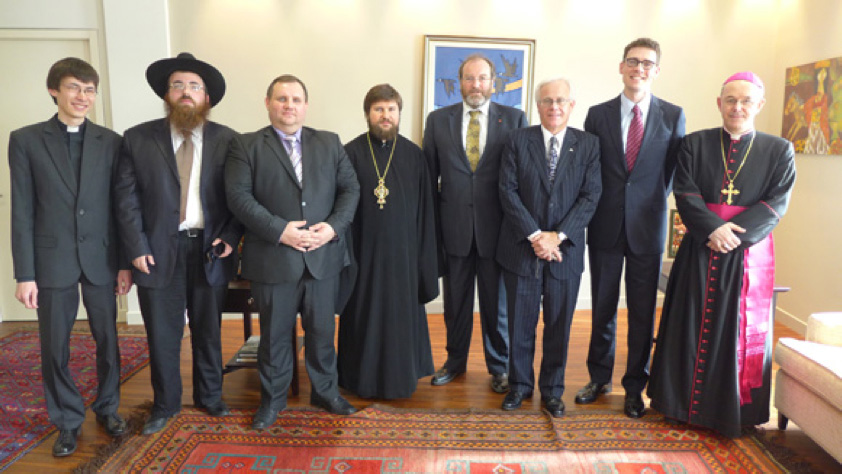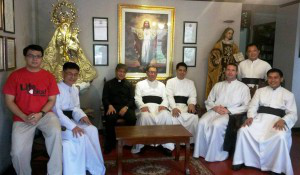Society of Saint Pius X: visits of prelates (new version)
On September 23, 2014, the Vatican published the following communiqué after a meeting between Cardinal Müller and Bishop Fellay :
Both sides […] agreed to proceed step by step, but within a reasonable time, towards overcoming difficulties with a view towards a full reconciliation.
What are these steps? DICI number 302, October 10, 2014, seems to answer the question:
It was decided to work towards doctrinal discussions “within a wider and less formal framework than the previous discussions”.
Rome left the choice of persons and places to Bishop Fellay.
Cardinal Brandmüller and Bishop Schneider
Cardinal Walter Brandmüller:
The 86 year old Cardinal Brandmüller was president of the Pontifical Committee of Historical Sciences from 1998 to 2009. Along with Cardinals Müller, Burke, Caffara and de Paolis, he is the co-author of the book called Remaining in the Truth of Christ, which opposes giving communion to divorced and remarried people.
He is a fervent disciple of the last pope. His mindset is revealed in the work The keys of Benedict XVI for the Interpretation of Vatican II. 1 There in particular you will read:
The Society of St Pius X and the “Old Catholics” who rejected the Teaching on Papal Infallibility of Vatican I both have in common that they reject the legitimate developments in Doctrine and in the life of the Church.
On May 21, 2012, on the occasion of presenting his book to the press, the Cardinal issued the following statement to Radio Vatican:
Dignitatis Humanae and Nostra Aetate are not binding on the doctrinal level. I do not understand why our friends in the Society of St Pius X are almost exclusively focused on these two texts. I regret that they do this because these two texts are the easiest to accept given their canonical nature.
Can we forget that these texts are the result of secret agreements with the Freemasons, the battles that ensued in order for these texts to be passed, and the disastrous consequences these texts unleashed: the disappearance of Catholic States and the Judaization of the Church?
DICI number 307, December 19, 2014, announced that a meeting between the German prelate and Bishop Fellay, accompanied by several priests, was held on December 5, 2014, at the seminary in Zaitzkofen.
Bishop Athanasius Schneider:
The 53 year old Bishop Schneider is the auxiliary Bishop of Astana in Kazakhstan since February 5, 2011.
According to Sandro Magister, the well-known Vatican insider, L’Homme Nouveau number 1500 considers the Bishop to be “the best student of Benedict XVI”. During the symposium Reunicatho held in Paris in January of 2014, Bishop Schneider made a resounding appeal for the reform as set out by Benedict XVI. At various points of his intervention, Bishop Schneider stated his position on the principal points of today’s question.
- The Council:
It is the Vatican II Council that gave a wider understanding of the Mystery of the Church according to the Teaching of the Fathers of the Church […]. Thus, the Church has been seen as “a people made one with the unity of the Father, the Son and the Holy Spirit” (Lumen Gentium 4) 2.
This is what Archbishop Lefebvre thought of this ecclesiology:
There is a new ecclesiology, that is clear.[…] In my opinion, this is exceptionally grave: it is absolutely impossible to say that there could be a new ecclesiology. We do not make the Church nor have we made the Church, and neither the pope, the bishops, history nor councils make the Church. She was made by Our Lord. […] This does not depend on us. Now, how can they say, all of a sudden: “Now because of Vatican II, there is a new ecclesiology”? It’s incredible. 3
- Ecumenism:
Ecumenism is necessary in order to be in contact with our separated brethren and in order to love them. From the depth of the challenge offered to us by the new paganism, we may and we must collaborate with non-Catholics who seriously wish to defend the revealed Divine Truth [which they reject!] and the Natural Law that God created [which they do not observe!] 4.
Bishop Schneider is actively involved in the ecumenical movement in Kazakhstan, as shown by this photo published by the official website of the Canadian government. It was taken on March 18th, 2013 during an ecumenical meeting at the Canadian Embassy in Astana, gathering together the different Catholic, Protestant, Orthodox (schismatic) and Jewish “religious leaders” of Kazakhstan.
On July 5, 2009, the French conciliar catholic newspaper La Croix (The Cross) published the following statement of Bishop Schneider during an interreligious “encounter” in Astana :
“Anything that can bring about a mutual knowledge and respect between religions is a good thing.”
It is important to note that a “parliament of religions” is held every year in Astana.

03-18-2013: Mgr Schneider meets with various “religious leaders” of Kazakhstan. - Pope Francis
In the same interview of May 30, 2014, with the Latin Mass Society, speaking of Pope Francis one year into his reign, Bishop Schneider said:
Let us be grateful to God that Pope Francis has not spoken in the manner that was expected by the media. Up to now, he expresses in all his official homilies the beautiful Catholic doctrine.
Bishop Schneider would do well to read the study done two months earlier by Alexander-Marie in Les Editions Du Sel and also published in Clovis: The strange reign of Pope Francis. The study reveals what the Pope believes on Islam, on Judaism, on laicizing of the State, on homosexuality and even on Freemasonry – in short – so much for “the beautiful Catholic doctrine”.
- The Liturgical Reform:
In his work, Corpus Christi 5, which is widely spread among those in favor of a regularization, Bishop Schneider sees that at the heart of the current problem is the lack of reverence during the distribution of communion:
The deepest wound of the present crisis in the Church is the wound of the Eucharist, the abuses regarding the Blessed Sacrament.
True, this is extremely grave. However, is not communion in the hand the direct consequence of the New Mass of Paul VI? Bishop Schneider does not question that at all. He even believes – as does his mentor, Benedict XVI – that the New Mass ought to enrich the traditional liturgy:
The insertion of some prefaces from the new missal as well as the insertion of new saints into the traditional liturgical calendar [for example Mother Teresa or John-Paul II?] would be a beautiful and a useful initiative. 6
Let us add at this time that the Mass itself is but one aspect of the conciliar revolution – the most serious is the uncrowning of Our Lord. We must always come to that because that is at the heart of our fight, just as Archbishop Lefebvre always said:
This is why we oppose [the present Rome], and this is why we cannot agree. It is not firstly a question of the Mass, because the Mass is just one of the consequences of the fact that they wanted to get closer to Protestantism and thus to change the worship, the sacraments, the catechism, etc.
The fundamental opposition between them and us is the Reign of Our Lord Jesus Christ. Oportet illum regnare, as St Paul tells us, Our Lord came in order to reign. They say “No”, and we, we say “Yes” with all the Popes. 7
In Fideliter of January/February 2015, Fr Toulza addressed the issue:
The crisis will not be solved by people who are more or less adequate unless these people renounce their inadequate principles, (he says pointedly). The restoration of the Truth and of the good in the Church has not begun nor will begin unless we question the very principles on which Benedict XVI and Francis both hold to, but each in an undeniably different way. 8
Re-read also what the Archbishop said:
I can hear them say: “You exaggerate! There are many good bishops who pray, who have the Faith, who are edifying, etc”. Were they saints, as soon as they accept the false Religious Liberty, hence the secular State; false ecumenism, and hence the admission of many ways of salvation; of liturgical reform, and hence of the practical negation of the Sacrifice of the Mass; of the new catechisms with all their errors and heresies, they officially contribute to the revolution within the Church and to its destruction. 9
Already in the spring of 2014, Bishop Schneider was received at the SSPX seminary in Zaiztkofen by the rector, Fr Schmidberger. While he was there, he gave a conference to the seminarians.
Within the framework of the meetings requested by Rome last September, two reunions have been scheduled:
- One reunion was to be held at the Saint-Cure d’Ars Seminary in Flavigny (France). This reunion already took place on January 15, 2015, during which Bishop Schneider gave two conferences to the seminarians. He also visited the nearby school of the traditional Dominican teaching sisters of Pouilly-en-Auxois (Congregation of Brignoles), where he gave a conference to the sisters. Before visiting Flavigny, Msgr Schneider had a reunion in the Ecclesia Dei Seminary of The Good Sheperd, in France, where he gave a conference to the seminarians.
- The next reunion was held at the St Thomas Aquinas Seminary in Winona (U.S.A.) in February, where he met 80 priests of the U.S. District.
Surprisingly enough, no announcement has yet been made of a visit to Ecône.
The relatively young Bishop Schneider, who is friendly with the Ecclesia Dei circles, is opposed to communion in the hand, does not mince words about the last synod, and likes the splendor and pomp of the traditional liturgy, and yet is imbued with “the strange theology” of Benedict XVI of whom he is considered the “best student”, no doubt has the ability to seduce more than one seminarian… or priest.
In the Philippines: Another Meeting
According to the November 25, 2014 official communiqué of the Episcopal Conference in the Philippines (CBCP), which published the following photograph, Fr Carlos Reyes, the secretary of the Episcopal Commission for Inter-religious Dialogue, visited on November 18 the SSPX priory in Manila in order to meet with Fr Nely, second assistant to Bishop Fellay, and also with the priests of the priory. They hoped to achieve this goal:
To develop cordial ties with this group, along the same lines as the September meeting held in the Vatican, and to reach full communion with the Church. Several canonical solutions were raised.

- Walter Brandmüller Le chiavi di Benedetto XVI per interpretare il Vaticano II, Sienna, Cantagalli, 2012.
- Bishop Athanasius Schneider, Interview with a French newspaper, Présent, January 10, 2015
- Archbishop Marcel Lefebvre, Spiritual Conference, Ecône, March 17, 1986.
- Bishop Athanasius Schneider, Interview with the Latin Mass Society, May 30, 2014.
- Athanasius Schneider, Corpus Christi, La communion dans la main au coeur de la crise dans l’Eglise, Editions Contretemps, 2014. Preface from Cardinal Burke.
- La Lettre de Paix Liturgique (a French “conservative” conciliar review) number 249, September 24, 2010.
- Archbishop Lefebvre, The Church infiltrated by Modernism, Editions Fideliter 1993, p. 70.
- Fr. Philippe Toulza, “the Tradition, the Church, the world”, Fideliter 223, January/February 2015, p. 70.
- Archbishop Lefebvre, Spiritual Journey, Prologue.
